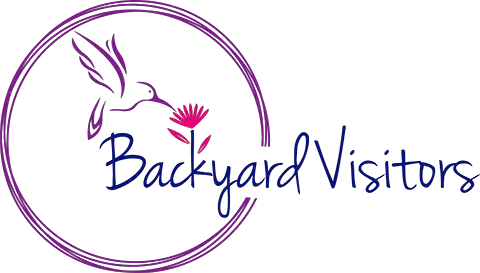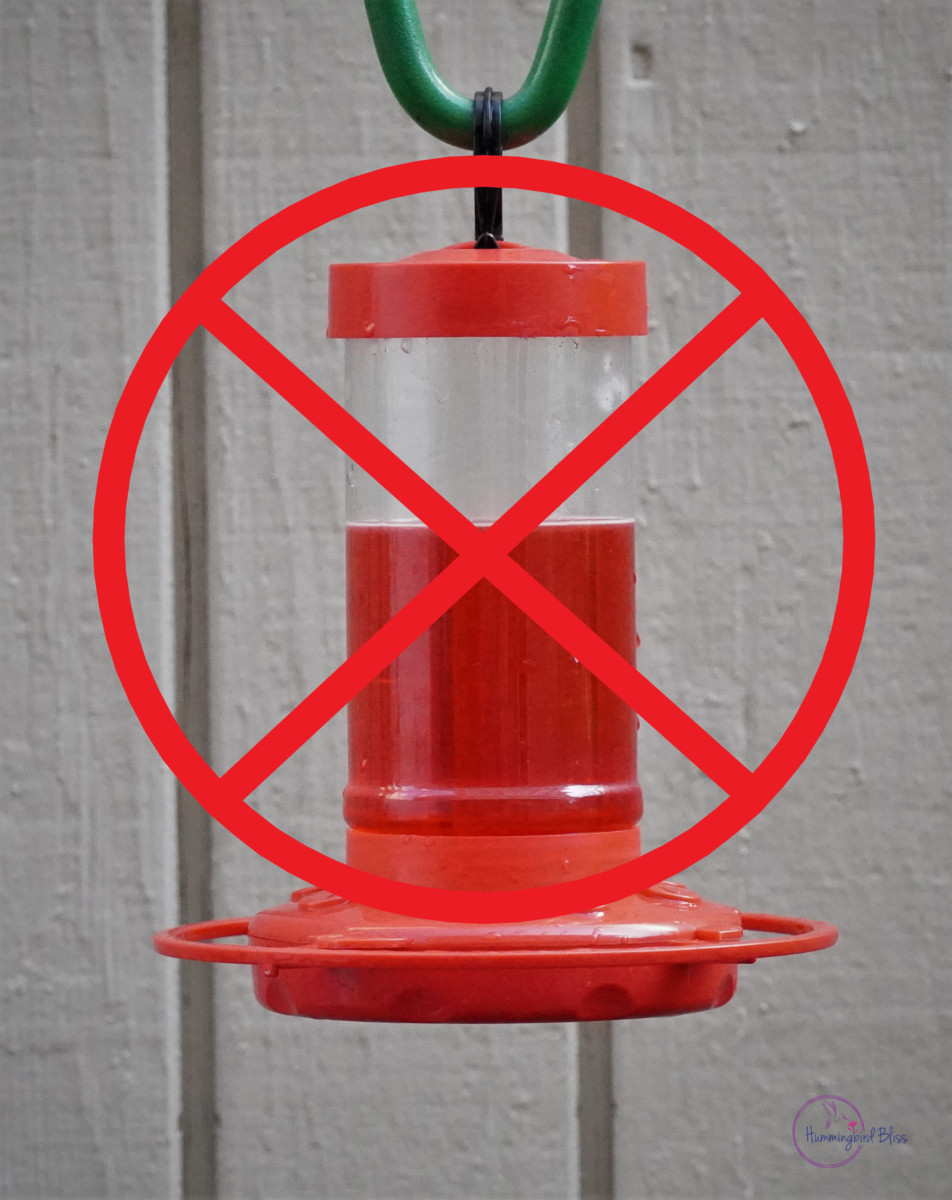This post contains affiliate links.
I was making homemade hummingbird nectar in my kitchen one morning and wondered if I should add red dye to the mixture and mimic what I see in store-bought commercial nectar.
I know for humans to ingest anything artificial is problematic and causes health concerns. I started to have second thoughts and realized that I avoid drinks with artificial coloring so maybe exposing this non-natural element into the bodies of hummingbirds might not be a good idea.
As a person who loves hummingbirds, I wanted to feel confident that I’m not harming my outdoor companions and I want to protect them when I make my homemade hummingbird nectar.
Is commercial red food dye harmful for hummingbirds to consume?
There is no substantial evidence or research to date stating commercial red food dye FD&C #5 and FD&C #40 is harmful or unsafe for hummingbirds to consume when added to commercial nectar. However, studies show ingesting large amounts of commercial red dye over a long period of time is unhealthy and project unforeseen health issues.
I am in love with my acrobatic outdoor companions and I wanted to be confident that their health, safety, and longevity were preserved. I feel it is important to share with you my findings on a variety of responses to this controversial question.
Commercial Hummingbird Nectar: Red Dye
The US Food and Drug Administration (FDA) defines a color additive or a food dye as any substance that conveys color to food, drug, cosmetic or to the human body. The Department of Health and Human Services is in charge of the Food and Drug Administration.
Color additives are considered safe with FDA regulations. There are many artificial and non-artificial red food colorings out on the market for the everyday consumer to purchase.
The FDA is not required to approve products on individual food label but mandates the nutritional value and information be labeled and available on most products for the consumer to read. The FDA stamp is stating that the benefits of the products outweigh the risks.
The most commonly used red dye is found in McCormick’s assorted food coloring box located at your local grocery store and is approved by the standards of the Food and Drug Administration.
Red food dye FD&C #5 and FD&C #40 are the two most common artificial dyes used and consumed in commercial hummingbird nectar. Artificial red food dye is a by-product of refined crude oil or coal. Crude oil is a natural type of fossil fuel that is refined to produce gasoline, diesel fuel, pavement, and tar.
Red food coloring is used to enhance the visual look and appeal of many commercial items and it does not necessarily enhance the taste of a particular product. Red dye will trick the human brain into thinking these products are natural and healthy. Red food dye has no nutritional value for humans or hummingbirds and is only used to augment the pigmentation of processed foods.
The most common synthetic red food dyes include:
- FD&C Red #40
- FD&C Red #5
- Citrus Red #2
FD&C Red #40 is known for its common term Allura Red. A few examples would be adding this dye to strawberry candy, sports drinks, flavored beverages, fruit snacks, breakfast cereals, hot dogs and beef jerky. Unexpected sources where you may find this is in synthetic butters, butter-flavored popcorn, and cold medicines.
FD&C Red #5 is found in commercially used hummingbird nectar.
Citrus Red #2 is only approved for use to color the outside of oranges and sausage casings per the FDA.
The 5 most common ingredients found in commercial hummingbird nectar with synthetic red dyes are:
- Water
- Sucrose (granulated white sugar)
- FD&C #40 (Red food coloring)
- Citric acid (a food preservative)
- Sodium benzoate (a food preservative)
Commercial hummingbird nectars are also made with preservatives allowing for a longer shelf life. Citric acid, Potassium sorbate, and Sodium benzoate are all common food preservatives in red commercial hummingbird nectar.
We tend to overlook the potential consequences of introducing red food dyes to a hummingbird’s diet. Knowing the source of where red food dye comes from will make anyone cringe and think twice about consuming let alone targeting a tiny defenseless hummingbird to these unnatural elements. The health risks are real and undeniable in large quantities so why risk it?
Many people want to provide their hummingbirds a place of sanctuary where they can limit harmful elements and protect their backyard companions. Removing red food dye from a hummingbird’s diet is a good place to start.
Commercial Hummingbird Nectar: Natural Red Dye
Carmine, carminic acid or cochineal extract are all keywords to describe natural red dye found on nutritional labels. These ingredients are safe to consume and they are derived from bugs.
What is natural red dye in hummingbird nectar?
Natural red food dye is produced from insects or flowers when used in commercial hummingbird nectar. The top two ingredients used commercially for natural red food dye in hummingbird nectar is carmine and hibiscus. The most common ingredients found in natural red dye hummingbird nectar include sucrose, carmine, and annatto.
Natural red hummingbird nectar purchased at the store has similar ingredients to commercial hummingbird nectar except the natural red nectar uses carmine or annatto as a color additive instead of artificial red dye FD&C #5 and FD&C #40.
The 5 most common ingredients found in commercial hummingbird nectar with natural red dye are:
- Water
- Sucrose (granulated white sugar)
- Carmine (Natural Red food coloring)
- Annatto (Natural Red food coloring)
- Hibiscus (Natural Red food coloring)
Carmine (E120) is derived from grinding up the scale cochineal insect to make the natural color red. It is a tropical insect that forages on plant moisture from cacti.
These insects are killed by boiling, drying and then grounding them into a powder. They are cooked at a high temperature to remove the maximum amount of red color.
Between the insect’s bodies and eggs, it is the eggs that can produce and extract the most coloring. It takes 80,000 to 100,000 insects to make one kilogram of cochineal dye.
Some common foods that contain this food coloring agent are some meats, fruit drinks, marinades, baked goods/toppings, cookies, icings, jams, and preserves. Colored dyed candies such as skittles also use carmine.
Annatto (E160b) is an orange-red seed coming from the achiote tree and is used for making dishes a yellow/orange color.
Some common foods that contain this food coloring agent are yellow cheeses, some white cheeses, bottled/commercial salad dressings, light-colored ice creams, yogurts, microwaveable popcorn, and coffee mate.
Other types of natural red dye include:
Lycopene (E160d) is a red carotene pigment in color that can come from fruits and vegetables such as cooked tomatoes, red cabbage, red carrots, watermelon, and asparagus.
The most common commercial food products that contain this food coloring agent are tomato-based products like ketchup, tomato paste, and spaghetti sauce.
These dyes are also used in the cosmetic industry and beauty products for hair/face like coloring pills and ointments such as lipsticks, face powders, and blushes.
The three most common products I found on the market using natural red dye in their hummingbird nectar were:
- Hummingbird Essentials
- Audubon Park
- Homestead products
All three products use sucrose as the number one ingredient. Hummingbird Essentials uses carmine and hibiscus as their color additive. Audubon Park uses cochineal extract, carmine, and annatto while Homestead uses carmine.
These brands carry no artificial red dyes or preservatives.
There are a variety of products available containing different combinations of natural red coloring that comes in a liquid concentrate and/or powdered form.
Common Side Effects of Synthetic Food Dyes
The most common side effects for the two synthetic food dyes listed above are IBS (Irritable Bowel Syndrome), diarrhea, abdominal pain and bloating.
There is not any sufficient or definitive evidence to prove that red food coloring is harmful when consumed over a long period of time, but research does show animals tested who consumed red dye lost weight, had problems with reproduction and had a poorer survival rate.
Studies on children who consumed more red food dye such as FD&C #40 in their diet showed higher signs of hyperactivity or ADHD. The side effects are not life-threatening but over time can cause unwanted or unforeseen health issues, food allergies or an intolerance level.
Other people might have an intolerance or an allergy to any of these food additives even though they are considered natural or artificial. Depending on the person, some may limit or avoid their intake to stay away from symptoms that can be unpleasant.
Other studies on hummingbirds have show evidence of when they are being fed red commercial nectar their excretions become stained with the color red. It takes over a day for the red dye to fully pass through their system even after they have discontinued this food regimen. Possible dangers where the red dye passes through the kidneys and doesn’t metabolize correctly can pose a risk over time.
Whatever negative side effects or health concerns that can happen to humans just imagine the kind of damage it could bring to smaller birds with less body mass? In my opinion, it is not worth taking that chance and exposing these elements to hummingbirds.
Commercial Nectars with Enriched Vitamins, Minerals, and Calcium
Natural red and artificial red hummingbird nectar products can add extra vitamins, minerals, and calcium to commercial nectar.
The thought behind this theory is the vitamins and calcium are introduced to strengthen and protect hummingbird eggs. Calcium enriches the integrity and structure of the egg. A hummingbird’s diet and the calcium they consume play an increased role in the quality of the shells of their eggs.
The likelihood of a broken or cracked hummingbird egg becomes more apparent when not enough calcium is consumed in their diet.
The stronger durable outer shell prevents eggs from cracking when they are being laid and benefits the production of prominent and successful offspring.
Homemade Hummingbird Nectar
To be safe and to eliminate any unwanted health issues related to your hummingbirds the easiest and most affordable way to provide them with a natural food source is to make homemade hummingbird nectar.
All it takes is sugar and water without using synthetic or natural dyes. The nutritional value in sugar water is greater than artificial commercial nectar.
See my article: Forget Commercial Hummingbird Food Try Making Homemade Nectar
Eliminating red food dye from a hummingbird’s diet when making your homemade nectar will reduce the chances of producing unanticipated health issues.
Final thoughts
Attracting hummingbirds to your area using red food dye FD&C #40 when making homemade nectar is unnecessary. The red base on the feeder is enough to attract hummingbirds while keeping them safe, healthy and eliminating the red dye from their diet.
In my opinion, to aid in the overall health and longevity of a hummingbird it’s best to eliminate synthetic or natural red food dyes when making homemade nectar.
Happy Hummingbird Watching!
Backyard Visitors participates in affiliate programs which compensate us for referring traffic.


